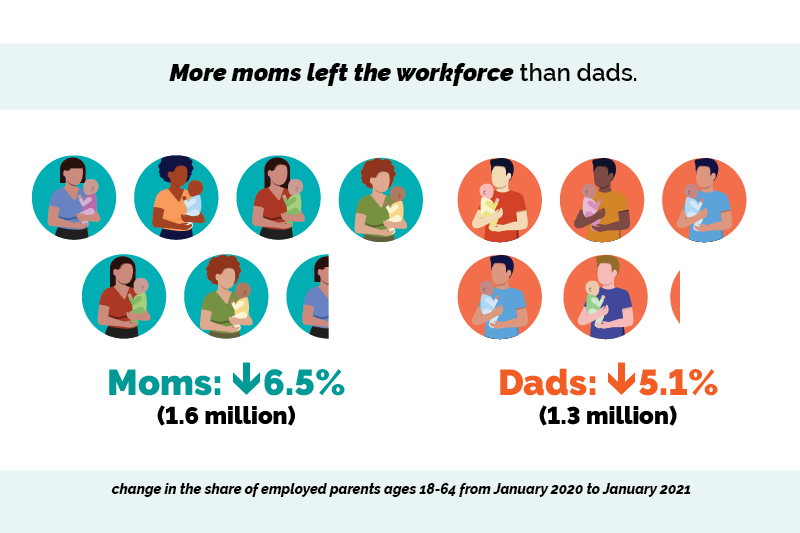With widespread closures of schools and childcare centers, COVID-19 kicked away the scaffolding of care working families rely on to balance the demands of work and family. Mothers, in particular, have borne a heavy load.
While the amount of time and energy they spend on unpaid labor at home has skyrocketed, their employment has suffered. Along with increases in household food insecurity, many moms also reported other effects of the pandemic beyond the labor market, including increased stress and anxiety. As the United States approaches its second pandemic Mother’s Day, here are five facts about how the pandemic has affected moms.

1. Maternal employment took a hit due to school and daycare closures
Even before the pandemic, childcare responsibilities fell primarily to mothers. Despite progress in this area, moms still spend almost twice as much time caring for kids as fathers do. The onus of child care and homeschooling continued to fall primarily on women in the pandemic: Among adults ages 25-44, out-of-work moms were nearly three times as likely (32% vs. 12%) as out-of-work dads to cite COVID-related childcare issues as the reason they were not employed, in a July 2020 survey.

2. More moms left the workforce than dads
About 1.6 million fewer mothers of children under 18 were working in January 2021 than in January 2020, representing a 6.5% decline. In comparison, the number of working fathers declined by 1.3 million, or 5.1%. Not only were fewer moms working, but many employed moms scaled back on working hours to a larger extent than fathers.

3. Moms with young kids were more affected
Among moms, workforce exits in the past year were linked to the age of their children: 9% of those with preschool-aged children left the workforce between January 2020 and January 2021, as did 8% of moms with children ages 6-12, but just 1% of moms with children ages 13-17.

4. Asian and Black moms faced the steepest employment losses
Between January 2020 and January 2021, 11% of Asian working moms with children 12 or younger and 10% of Black moms left the workforce. In comparison, 8% of white mothers did so, as did 7% of Hispanic moms. Racial and ethnic variations in employment losses were due in part to systemic racism, reflected in factors such as occupational segregation and disparities in unemployment and access to paid leave.

5. Impacts extended far beyond the labor market
A year into the pandemic, 58% of mothers reported that worry or stress related to the coronavirus has negatively affected their mental health, according to a recent survey. The increase in their unpaid work – both childcare and housework – along with increased job loss are important factors contributing to relatively high levels of anxiety and insomnia. These unpaid work demands and job loss rose along with food insecurity in households with children. By the summer of 2020, the share of households with children that did not have enough food more than doubled, from 14% pre-pandemic to more than 30%, with higher rates in households with children of color.
The pandemic has presented stark reminders of the present system’s gross inadequacy in supporting working moms. This is a pivotal moment, full of promise. We are truly on the cusp of bold, transformative policymaking that meets the needs of mothers and their families, both in the home and in the workplace.
The Biden-Harris administration has already provided immediate financial support to families and small businesses with the American Rescue Plan. The next step is to implement the American Jobs Plan and the American Families Plan. Doing so will help build a new economy – one that recognizes that care work is infrastructure, that it undergirds strong families, and is essential to a prosperous economy.
By creating a national paid family and medical leave program, increasing the size of the country’s care work infrastructure, improving benefits and wages so that the care workforce can support their own families, and implementing tax credits and financial supplements with historic potential for reducing child poverty, these plans will create long-overdue supports so parents won’t have to choose between caring for the families they love, and keeping their jobs.
Find more data on working mothers on the Women’s Bureau’s website.
Wendy Chun-Hoon is the director of the U.S. Department of Labor’s Women’s Bureau. Follow the Women’s Bureau on Twitter at @WB_DOL.

 U.S. Department of Labor Blog
U.S. Department of Labor Blog




